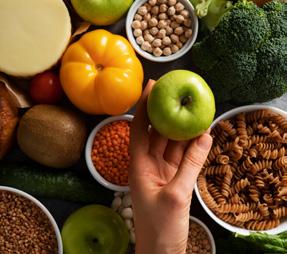
2 minute read
Phyto-oestrogens: good or bad?
The impact of the dietary consumption of these plant compounds, with a chemical structure similar to oestrogen, has yet to be well understood.
There are several types of phyto-oestrogens, the most common being isoflavones, lignans and coumestans. Isoflavones are found in soybeans and soy products. Lignans are abundant in flaxseeds, wholegrains, and certain fruits and vegetables. Coumestans are present in alfalfa sprouts and clover.
Phyto-oestrogens interact with oestrogen receptors (ERs), have a higher affinity for ERβ than for ERα, and exert oestrogenic or antioestrogenic effects. However, not all biological effects of phyto-oestrogens involve the ER.(1.) They can also activate the serotoninergic and insulin-like growth factor-1 receptors, induce free radical binding, and modify tyrosine kinases, cyclic AMP, MAP proteins, and the PI3K/Akt pathway. In addition, they can act as intracellular regulators of apoptosis and the cell cycle. Hence, phyto-oestrogens have gained attention for their antioxidant, antiproliferative, antimutagenic and antiangiogenic potentials.
Phyto-oestrogens may lower the risk of osteoporosis, some cardiometabolic diseases, cognitive dysfunction, breast and prostate cancer, and menopausal symptoms. This occurs through modulation of the endocrine system. However, phyto-oestrogens have also been described as endocrine disruptors, and some believe that their beneficial effects have been overestimated.
The impact of phyto-oestrogens can vary according to life stage. In children, there is poor evidence that phyto-oestrogens alter sex hormones and have goitrogenic effects in conditions of insufficient iodine intake. In adulthood, some effects have been found only in men (goitrogenic effects and reduction of insulin levels in patients with non-alcoholic fatty liver disease) and in menopausal women (improvement of the glycometabolic profile, goitrogenic effects and reduction of cardiovascular risk factors). No effects were found in premenopausal women. There is particular concern about how they act in pregnant women, as this has been poorly studied. However, the available evidence suggests an improvement in insulin metabolism.(2.)
In general, the available evidence for an association between dietary phyto-oestrogens and endocrine function is inconclusive. The disparity in results may be due to differences in the types and concentrations of the compounds administered. This could influence phyto-oestrogen bioavailability and consequently hormonal function. There is a need for further, well designed, randomised control studies to clarify the effects of dietary phyto-oestrogen consumption on the human endocrine system.
Settimio D’Andrea, Italy
REFERENCES
1. Huang et al. 2023 Biomedical Pharmacotherapy 160 114341 https://doi.org/10.1016/j.biopha.2023.114341
2. Domínguez-López et al. 2020 Nutrients 12 2456 https://doi.org/10.3390/nu12082456







